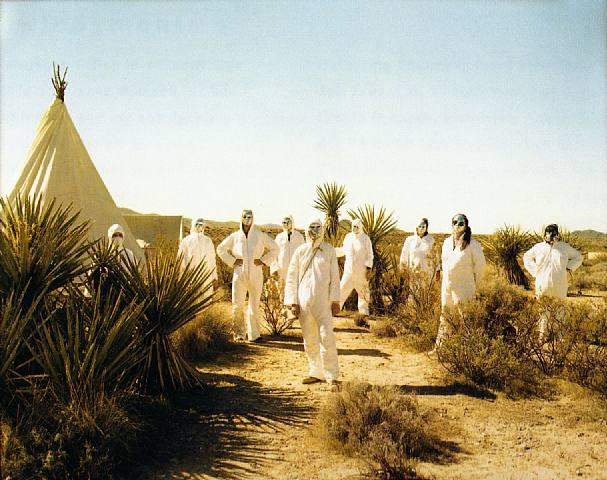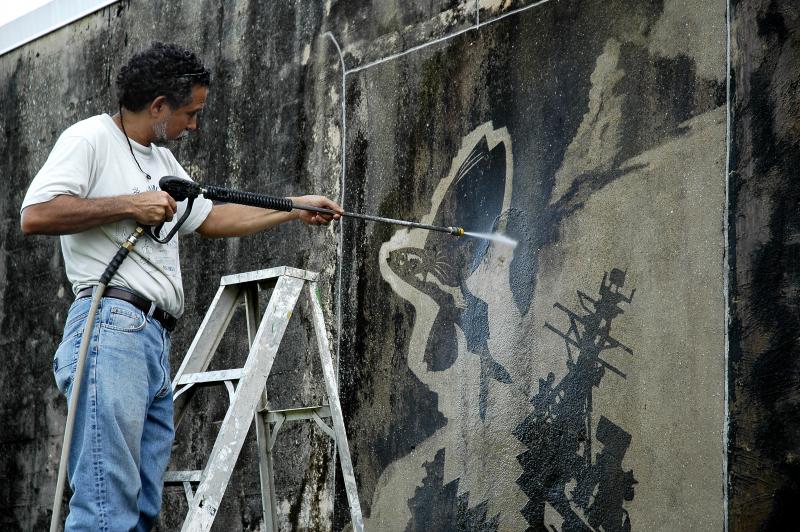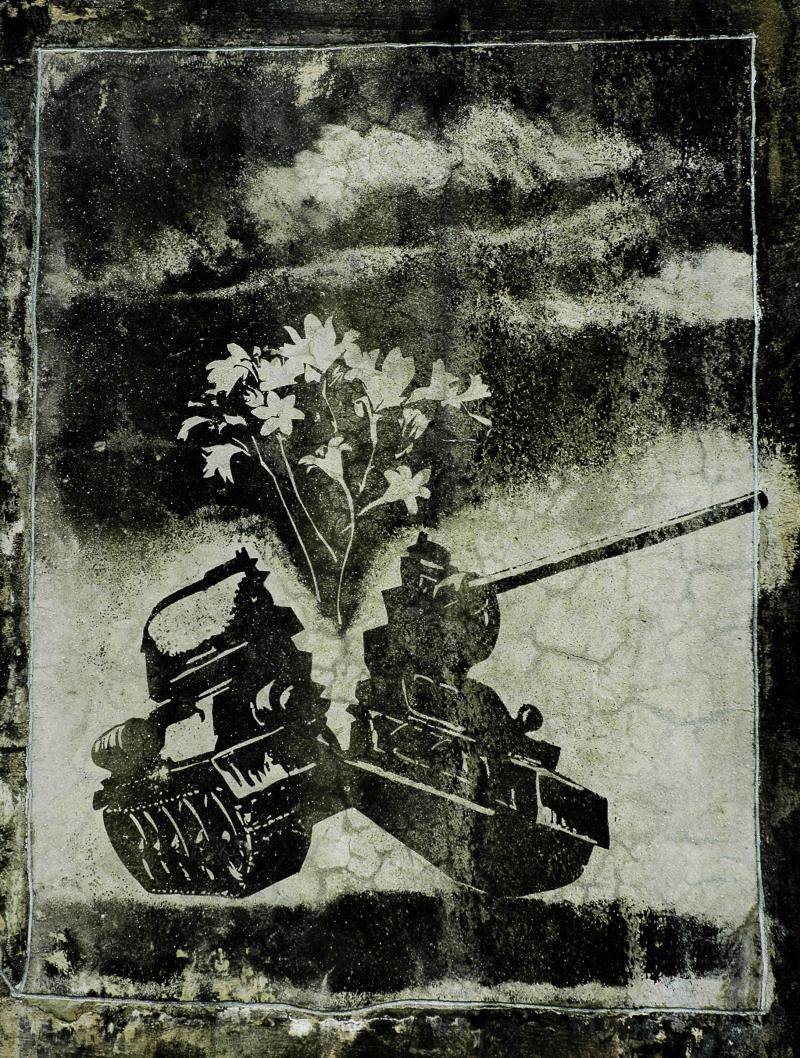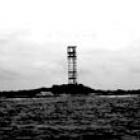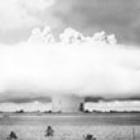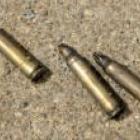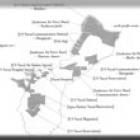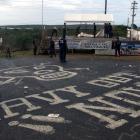Reclamations
Whereas images and stories represent the social and environmental harm produced by landscapes of militarization, public demonstrations, occupations, and site-specific artworks attempt to reclaim and demilitarize US bases themselves. These unauthorized performances challenge discourses of national and international security by asserting the people’s right to occupy and dispose of their territory, and by envisioning alternative futures for militarized spaces. While the actual reclamation of militarized space is an arduous process involving international negotiations and years of environmental mitigation, unauthorized appropriations of these spaces symbolically assert local authority over the extraterritorial power of the US, which frequently endangers local populations in the name of global peacekeeping.
At the Nevada Test Site, where nuclear weapons were regularly detonated between 1951 and 1992, protestors representing a range of interests (including Western Shoshone, nuclear bomb survivors from Japan, peace activists, anarchists, and environmentalists) engaged in decades of civil disobedience actions culminating in the Comprehensive Test Ban Treaty signed in 1992. Putting their bodies at risk (not only of police violence and arrest but also of radiation exposure), protestors transformed the Test Site into a space for building community and solidarity between diverse activists, and for demonstrating the power of nonviolent protest against military violence. Protestors in other locations have taken up this strategy of illegal occupation: in the 1980s, the Marshallese performed “sail-ins” to reoccupy lands from which they had been evacuated by the US military (Kuletz 2002, 138); for the past sixteen years, activists have maintained a tent encampment to protest US base expansion in Henoko, Okinawa; and in light of the accidental death of civilian David Sanes from an errant bomb in Vieques, activists set up peace encampments until they were removed by the federal marshal and the FBI in May 2000.
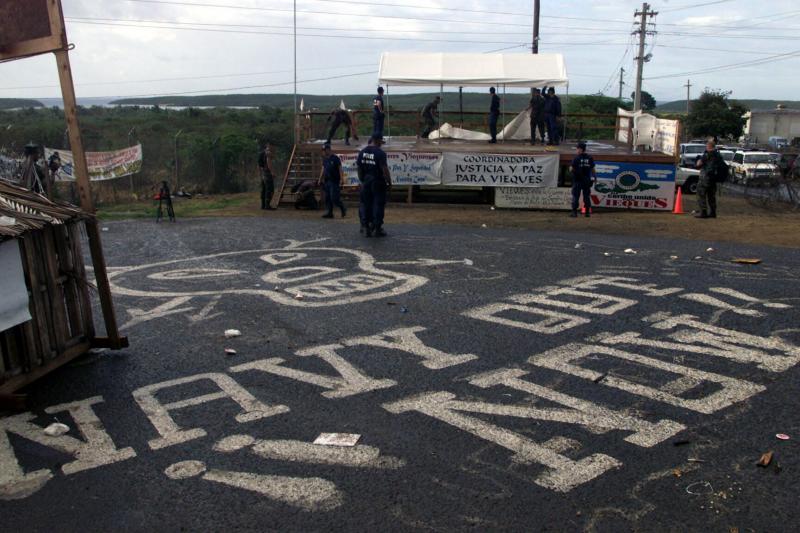
US Military disassembling the staging area at Camp Garcia in Vieques after a one-year occupation by protestors
US Military disassembling the staging area at Camp Garcia in Vieques after a one-year occupation by protestors
PH2 J. B. Keefer, USN (4 May 2000)
 This work is licensed under a Creative Commons Public Domain Mark 1.0 License.
This work is licensed under a Creative Commons Public Domain Mark 1.0 License.
In addition to the crucial work of contesting military claims to space, illegal trespassing and peace encampments create politically charged spaces for cultural projects and performance art. The Princesses Against Plutonium, a group of activists who trespassed the Nevada Test Site dressed in body suits and death masks and handed out fliers warning workers to evacuate the contaminated area, used costume and staging to dramatize the invisible and frequently indeterminate risks associated with radiation exposure. Although the nine women were arrested after the April 1988 action, they “inspired hundreds of ‘copycat’ invasions and arrests, which jammed the courts and ultimately resulted in the charges against the Princesses being dismissed” (Misrach, 15). At the Okinawa encampment, performers draw on “elements of Japanese popular theater, comedic storytelling, and musical genres ranging from the traditional to rock and 1960s-style folk” in efforts to build community and cooperation among an eclectic group of protestors (Nelson 2012, 831).
Wall art at the abandoned US Navy base at Vieques celebrates the victory of peace protestors and the closing of the base. These works depict resurgent nature—flowers, fish, and butterflies—bursting from broken military equipment. Because the artist, Rafael Trelles, created these images by washing away portions of the wall around stencils of his images, his artwork literally diminishes the walls of the naval base. Even while Vieques residents suffer from extraordinary rates of cancer, cirrhosis of the liver, kidney failure, hypertension, diabetes, birth abnormalities, stillbirths, and miscarriages, artwork like this raises important questions about how to repair the landscape in the wake of military activity: fish and plants growing out of defunct tanks may be beautiful, but they are probably contaminated. Even as struggles for environmental cleanup and reparation continue, public works of art, performance, and reoccupation begin to envision alternative uses and futures for militarized landscapes and the global communities affected by them.
Bibliography:
Jaccard, Helen, and David Swanson. “Vieques 10 Years After the Bombing Stopped.” RootsAction, April 17, 2013.
Kuletz, Valerie.“The Movement for Environmental Justice in the Pacific Islands.” In The Environmental Justice Reader: Politics, Poetics, & Pedagogy, edited by Joni Adamson, Mei Mei Evans, and Rachel Stein, 125–42. Tucson: University of Arizona Press, 2002.
Nelson, Christopher. “Occupation without End: Opposition to the US Military in Okinawa.” South Atlantic Quarterly 111 no. 4 (2012): 827–38.
Misrach, Richard. Commentary on Princesses Against Plutonium, Nuclear Test Site, Nevada, 1988.
Solnit, Rebecca. “Dust, or Erasing the Future: The Nevada Test Site.” In New West Reader: Essays on an Ever-Evolving Frontier, edited by Philip Connors, 175–206. New York: Nation Books, 2005.


